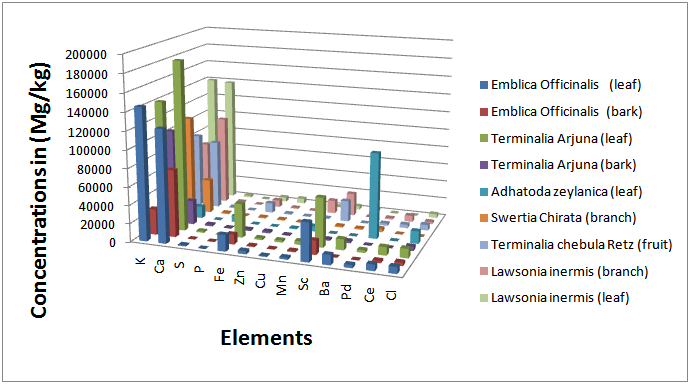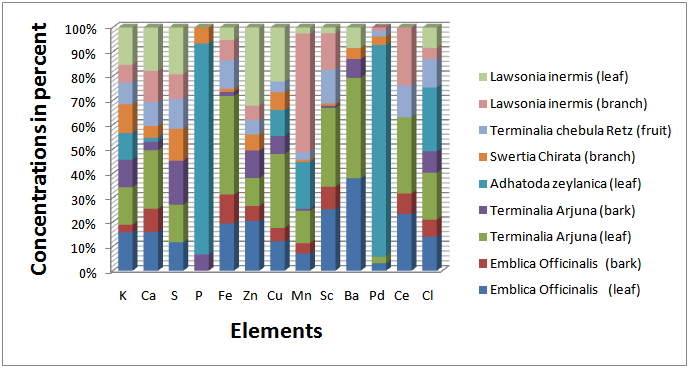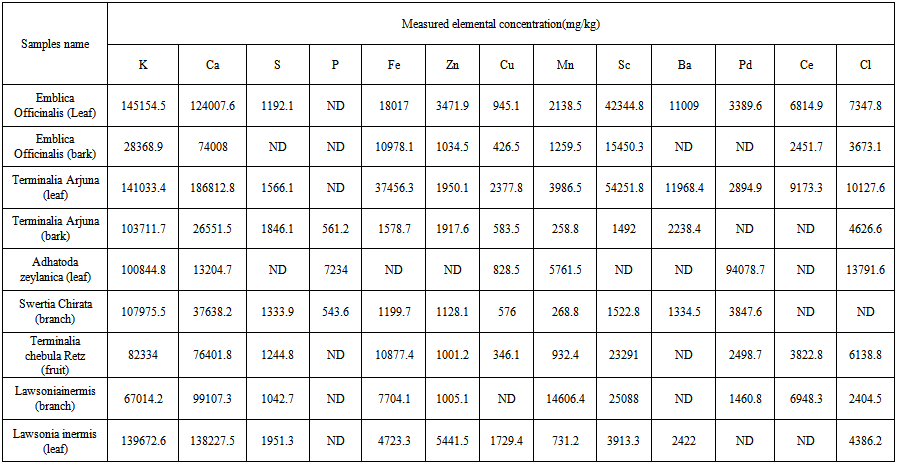-
Paper Information
- Next Paper
- Paper Submission
-
Journal Information
- About This Journal
- Editorial Board
- Current Issue
- Archive
- Author Guidelines
- Contact Us
Journal of Nuclear and Particle Physics
p-ISSN: 2167-6895 e-ISSN: 2167-6909
2014; 4(1): 1-6
doi:10.5923/j.jnpp.20140401.01
Study of Elemental Profile of Some Medicinal Plants of Bangladesh
S. M. Fahad1, Md. Joynal Abedin2, M. Mehade Hasan1, Md. Obaidur Rahman1, S. M. Azharul Islam1, Mir Md. Akramuzzaman1, Mohammad Russell3
1Department of Physics, Jahangirnagar University, Savar, Dhaka, Bangladesh
2Accelerator Facilities Laboratory, Atomic Energy Center, Dhaka, Bangladesh
3Department of Chemistry, Jahangirnagar University, Savar, Dhaka, Bangladesh
Correspondence to: S. M. Fahad, Department of Physics, Jahangirnagar University, Savar, Dhaka, Bangladesh.
| Email: |  |
Copyright © 2012 Scientific & Academic Publishing. All Rights Reserved.
Essential and trace elements in medicinal plants of saver near the Dhaka city in Bangladesh have been measured using particle induced X-ray emission (PIXE) technique. The sample were dried, pressed to make pellet and then bombarded with accelerator proton at 3 MV Van de Graff Accelerator laboratory of Atomic Energy Centre, Dhaka, (AECD). The X-ray emitted in the irradiation were measured by Lithium Drifted Silicon Detector Si (Li). The scattering chamber with associated all other circuitry and software MAESTRO-32 has been used for data acquisition and the collected data has been analyzed using GUPIX software. A number of major and trace elements were found to be in varying concentrations in the investigated medicinal plants. The contents of K and Ca are being notably large in medicinal plants samples. No toxic elements were detected in the investigated samples.
Keywords: Van de Graff Accelerator, PIXE, Si (Li) detector, MAESTRO-32 software, GUPIX software, Medicinal plants
Cite this paper: S. M. Fahad, Md. Joynal Abedin, M. Mehade Hasan, Md. Obaidur Rahman, S. M. Azharul Islam, Mir Md. Akramuzzaman, Mohammad Russell, Study of Elemental Profile of Some Medicinal Plants of Bangladesh, Journal of Nuclear and Particle Physics, Vol. 4 No. 1, 2014, pp. 1-6. doi: 10.5923/j.jnpp.20140401.01.
Article Outline
1. Introduction
- The natural plants which are used for the treatment of living beings are known as medicinal plant. More than five hundred types of medicinal plants are available in Bangladesh. From the very beginning of human society, medicinal plants are being used as raw materials of drugs. Medicinal plants are unique type of natural product requiring special consideration due to their potential impact on human health. The pharmacological properties of the medicinal plants have been attributed to the presence of active chemical constituents which are responsible for important physiological function in living organisms. It has been reported that trace elements play a vital role in the formation of the active chemical constituents present in medicinal plants and are therefore responsible for their medicinal as well as toxic properties[1]. The various major, minor and trace elements concentration are important for determining effectiveness of medicinal plants in treating various diseases and to understand their pharmacological action.The study of both major & trace elements, in biological, environmental and agricultural materials has assumed growing importance for performing their vital role in human health and diseases. Trace elements perform important metabolic functions. These elements may be an integral part of the enzyme protein molecule or they may be activators of the enzyme. Some important trace elements are also involved in the synthesis of hormones, vitamins, protein, DNA and RNA. Any deficiency or increase in their normal level in living cell may lead to the physiological disorders & diseases like dental caries, anemia, cancer, heart diseases, obesity, osteoporosis, arthritis etc. To ensure proper diagnosis and treatment planning, the information on elemental analysis of medicinal plants is essential.The possibility of incidence of contamination in air, water supply, food with trace elements, arising from modern agriculture & industrial practices, and from increasing urbanization, of a section of community, may have toxic effects on the long term health and safety of the whole population. It is therefore, essential to have information on the nature and the extent of the actual elemental concentration of medicinal plants for the betterment of health and welfare of human population[2-6, 7].
2. Methodology and Experimental
2.1. Study Area
- Savar is located in between latitude 23.8583°N and longitude 90.2667°E. It has 66,956 units of household and a total area of 280.13 square kilometres (108.16 sq miles). It is bounded by Kaliakair and Gazipur Sadar upazilas on the north, Keraniganj upazila on the south, Mirpur, Mohammadpur, Pallabi and Uttara thanas of Dhaka City on the east, and Dhamrai and Singair upazilas on the west. The land of the upazila is composed of alluvium soil of the Pleistocene period. The height of the land gradually increases from the east to the west. The southern part of the upazila is composed of the alluvium soil of the Bangshi and Dhalashwari rivers. Main rivers are Bangshi, Turag, Buriganga and Karnatali. The Bangshi River has become polluted due to industrial waste.The total cultivable land measures 16,745.71 hectares (41,379.6 acres), in addition to fallow land of 10,551.18 hectares (26,072.5 acres)[8]. Figure 1 shows the study area.
 | Figure 1. Location map of Savar Upazila in Bangladesh |
2.2. Methodology
- In this modern scientific society a number of analytical methods are used for elemental analysis. One single method can provide all the answers of so diverse nature problem. Developments of complementary techniques are very much needed for the analysis of all groups of elements present in a sample. PIXE has been used in this study. PIXE is highly sensitive, non-destructive and multi-elemental ion beam technique which has wide applicability in numerous fields. PIXE has advantage due to large cross-section of X-ray production and the background contribution from bremsstrahlung is low. The most important minor and trace elements can be determined in single run within short time.In the view of above considerations, the present work was undertaken to determine essential and trace elements in various medicinal plants using PIXE technique at 3 MV Van de Graff accelerator Atomic Energy Center, Dhaka (AECD).
2.3. Sample Collection & Preparation
- The samples of various medicinal plants such as Nim, Tulshi, Basok, Bohera, Amloki, Arjun, Chirota, Hortoki, and Mehedi were collected in season of June, 2012 from Savar near the Dhaka city of Bangladesh. Samples were dried in “Memmert Schutzart DIN 40050 – IP 20” oven. Normally the temperature of the oven kept under 100ºC. But temperature of the oven should be varied due to the structure and condition of the sample to be dried. Setting requirements of the oven can be controlled. The dried samples were ground with a gate mortar. Samples were pelletized using Hydraulic pressure and pellets were 10 mm in diameters and 1mm in thickness.
2.4. Irradiation and Data Acquisition
- The prepared sample in the form of pellet was irradiated with proton beam of 2.3 MeV using 3MV Van de Graff Accelerator laboratory of Atomic Energy Centre, Dhaka (AECD). During the irradiation, the beam current was in the range of 10µA-15 µA. The X-ray emitted in the irradiation were measured by using Si (Li) detector.
2.5. Data Analysis
- For PIXE method, we collected the data of different elements through measuring the peaks from the spectrum saved by MAESTRO software of different softwares . The X-ray spectrum has been analyzed to measure the concentration using GUPIX software. The acquired data were saved in a special GUPIX file format with some necessary header information, in the pre-defined folder. Thus data were collected in PIXE analysis. The calculation of elemental concentration Cs is based on the following well known equation:
 Putting the values of the concentration of the standard sample, Cst . Ss the stopping powers of the sample, stopping power of the standard, Sst the yield of the sample, Ys and the yield of the standard, Yst in the above equation we determined the concentration of the elements.
Putting the values of the concentration of the standard sample, Cst . Ss the stopping powers of the sample, stopping power of the standard, Sst the yield of the sample, Ys and the yield of the standard, Yst in the above equation we determined the concentration of the elements.3. Results and Discussions
- The research work has been done using the beam energy of 2.3 MeV and current range 10nA-20nA. Medicinal plants Ocimum sanctum (Tulshi), Terminalia belerica (Bohera), ADHATODA ZEYLANICA (Basok), Terminalia chebula Retz (Hortoki), Lawsonia inermis (Mehedi), Terminalia Arjuna (Arjun), Emblica Officinalis (Amloki), and Swertia Chirata (Chirota) were selected as medicinal plant, collected, prepared, irradiated and analyzed. The detected elements from the samples are Calcium, Potassium, Manganese, Phosphorus, Iron, Copper, Zinc, Sulfur etc. and their concentrations have been presented in Table 1. The measured concentration of those elements are shown in Figure 2 and Concentrations of elements in percentage of all experimented medicinal plants are shown in Figure 3. According to the experimental concentration of the elements found in the medicinal plants, it is observed that Emblica Officinalis (Amloki leaf) contains the higest amount of K (145154.5 mg/kg) and lowest amount of K is exhibited by Emblica Officinalis (Amloki bark) (28368.9 mg/kg). The high concentration of Potassium is very significant because it plays to build proteins and muscles, breakdown and use carbohydrates. It also controls electrical activity of heart and the acid-base valence. Calcium is also found in all the samples of medicinal plant and the concentration is also relatively high but not high as Potassium. Terminalia Arjuna (Arjun leaf) contains the higest amount of Ca (186812.8 mg/kg) and lowest amount of Ca is exhibited by ADHATODA ZEYLANICA (Basok leaf) (13204.7 mg/kg). Sulfur is a major element and found in the samples except, ADHATODA ZEYLANICA (Basok leaf), and the concentration is relatively low.Iron is present in almost all the samples except ADHATODA ZEYLANICA (Basok leaf). Its concentration is also relatively high. The highest Fe content is found in Terminalia Arjuna (Arjun leaf) (37456.3 mg/kg) and the lowest in Swertia Chirata (Chirota branch) (1199.7 mg/kg). Iron is known to be an important element for human body and to keep healthy as well as strong. Not only this, for instance, it is common knowledge that the iron together with hemoglobin and ferro-doxin play important roles in metabolism. The experimental values show that the concentration of Fe fluctuates in different samples of medicinal plants. Phosphorus is present in some samples. It’s concentration also fluctuates.The concentrations of Copper are relatively high and found in all medicinal plant samples studied. The copper is very significant for human life for the formation of hemoglobin in the blood along with iron. The concentration of Zn is also relatively high. It plays very important role in human life. Zinc is especially important during pregnancy, for the growing fetus whose cells are rapidly dividing. Zinc also helps to avoid congenital abnormalities and pre-term delivery. The concentration of Mn are present in all medicinal plants. The concentration of Mn is also found in different ranges. Manganese helps the body form connective tissue, bones, sex, hormones, enzymes and synovial fluid in the joints.
 | Figure 2. Concentration of elements in medicinal plants |
 | Figure 3. Concentrations of elements in percentage of all medicinal plants |
 | Table 1. Elemental concentration of the investigated medicinal plants |
4. Conclusions
- The PIXE has been used for the elemental analysis of some medicinal plants commonly consumed in Savar near the Dhaka city of Bangladesh. The concentration of the K, Ca, Fe, Zn, Cu, Mn, S, P, Sc, Ba, Pd, Cl and Ce elements of those samples have been measured. It is found that K and Ca are the most abundant detected elements in the samples. The results found by this study of the medicinal plants’ samples such as Terminalia belerica (Bohera), Emblica Officinalis (Amloki), Swertia Chirata (Chirota), Lawsonia inermis (Mehidi), ADHATODA ZEYLANICA (Bashok), and Terminalia chebula Retz (Hortoki) are great important for Pharmaceutical industries for medicine and drug production. Similar further study may provide sufficient knowledge to evaluate the significance of the importance especially related to human health.
ACKNOWLEDGEMENTS
- The authors are thankful to staff of Van de Graff Accelerator division, Atomic energy center Dhaka (AECD) for their help in preparation of samples and Irradiation.
 Abstract
Abstract Reference
Reference Full-Text PDF
Full-Text PDF Full-text HTML
Full-text HTML